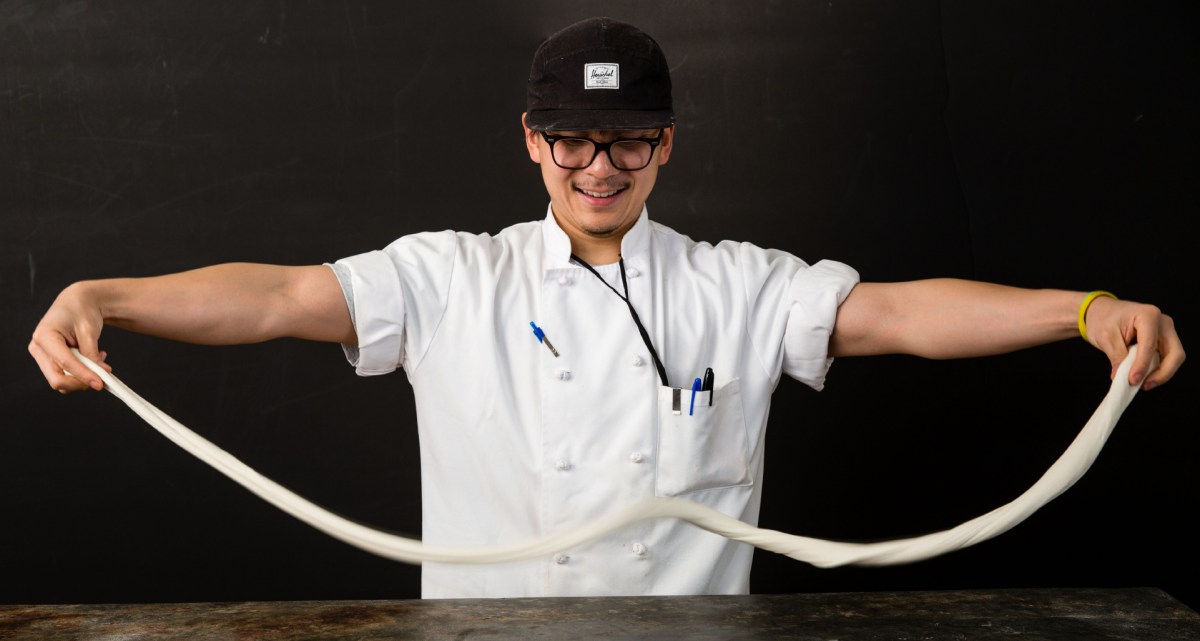Lifting his head out of his sixth bowl of noodles, Cook’s Science Test Cook Sasha turned to me and conceded defeat. “I don’t know if I’m gonna make it. My face is sweating.”
We were three stops into our research tour—on the hunt for the best hand-pulled noodles Boston had to offer and some techniques we could bring back to the test kitchen.
After all, we’ve been talking about noodles a lot at Cook’s Science, ever since we started working on our profile of noodle obsessive Ken Albala, which ran last week. We knew we wanted to develop our own recipe for homemade hand-pulled noodles, and so decided to take a closer look at the local Chinese noodle scene in hopes of developing a couple of straightforward recipes for wheat-based hand-pulled noodles.

In general, there were two different kinds to seek out: flat and wide hand-pulled noodles, and thin and delicate hand-pulled noodles. A number of spots serve the flat and wide variety in Boston, but we had to watch videos on YouTube and Instagram to see the process behind the thin (and particularly mesmerizing) ones. As a result, we decided to start with the flat and wide, and save the thin for later.
Not that it was all that easy to get tips for the bigger noodles. When we walked into Gene’s Chinese Flatbread Cafe in Downtown Crossing, the room echoed with sounds of cooks pulling, stretching, and slapping pieces of dough against the open kitchen counter. But the cooks were guarded when we spoke to them.
“Hell if I know what flour we use,” a woman barked at me in a heavy Northern Chinese dialect of Mandarin.
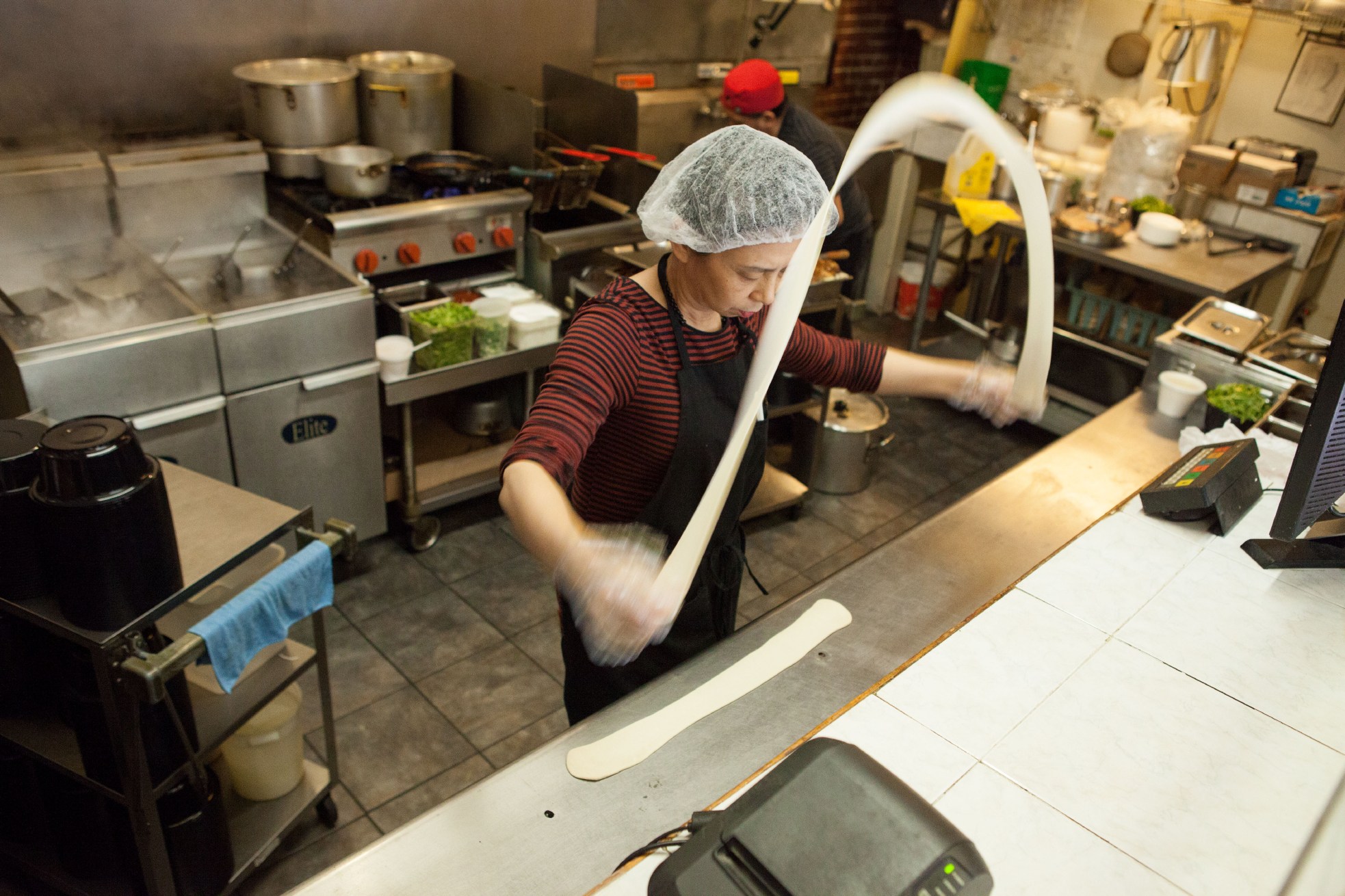
At MDM Noodles in Brighton, the story was much the same. Though Sasha and I were barred from entering the back kitchen, the manager, Stephen Ruan, managed to snag for us a quick video recording of MDM’s owner, Anna Ruan, pulling some noodles. In the video, Anna gently stretches and swings the soft, snow-white dough between her hands until it nearly touches the floor; she rips a perfect seam down the middle, dividing the noodle in half, then stretches the dough further before dropping it in simmering water.
And so began my journey down the noodle rabbit hole. For weeks, I buried myself in YouTube videos, online forums, and rough translations of Chinese Instagram posts from halfway across the globe.
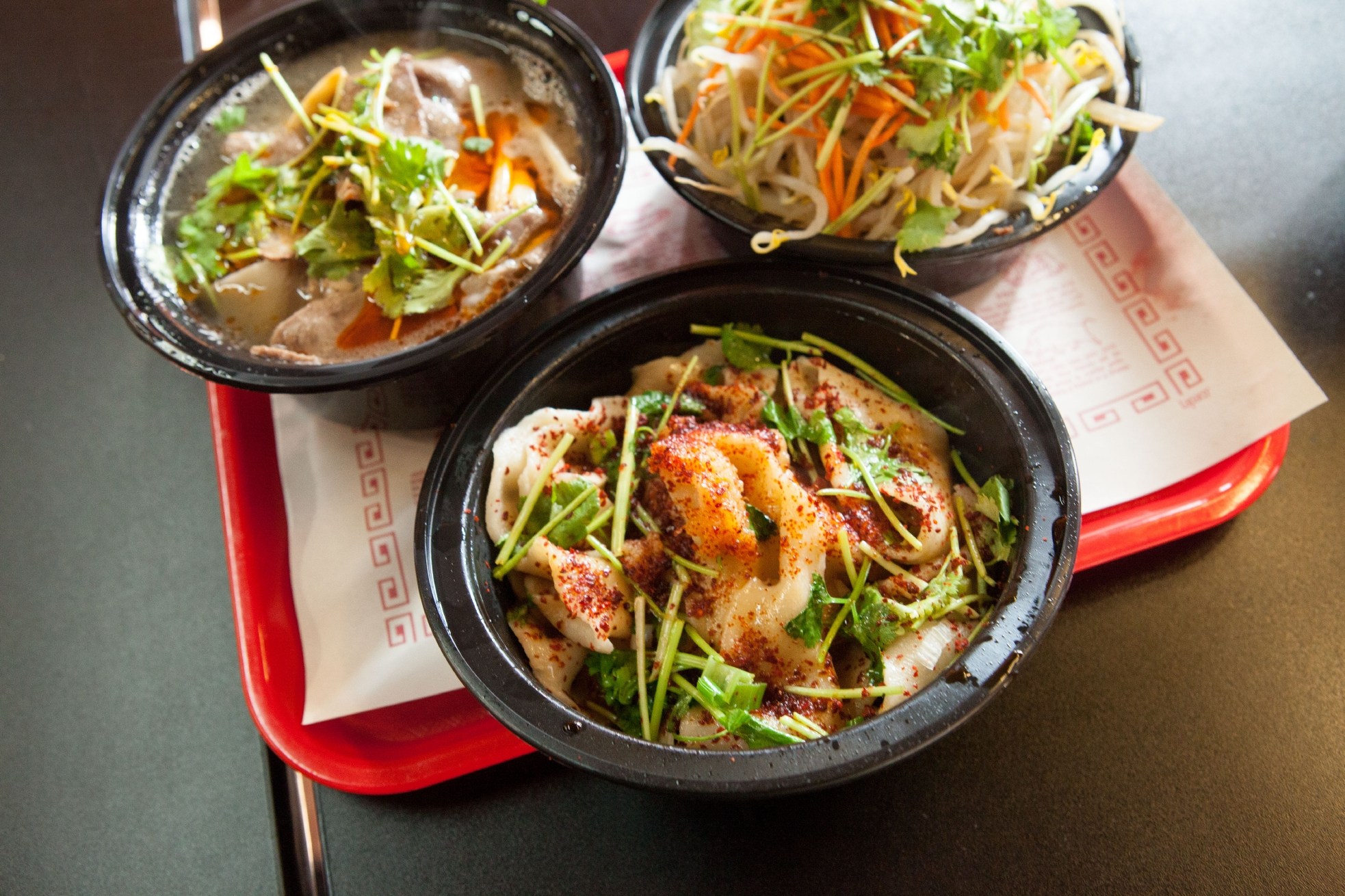
By our standards, the best flat, wide hand-pulled noodles have plenty of chew and elasticity. They are rustic by nature, with thicker and thinner sections, and nicely grab sauce like good Italian pasta.
The base ingredients for any wheat flour noodle are simple: wheat flour, water, and (sometimes) salt. I started with 10 different formulas, with varying hydration, flour type, and salt concentration. Some included oil or baking soda as well. I treated each dough the same: mixing, kneading it, resting it for three hours, portioning, and shaping and stretching the portions into long noodles. I cooked the noodles in simmering, salted water and dressed them in a chile oil vinaigrette.
A few trends emerged. The noodles that stretched and cooked best had at least 60 percent water by weight of flour, the perfect amount for creating a strong and stretchable gluten network. Any less and they were noticeably stiffer, tearing easily when stretched. Any more and the cooked noodles took on a gummy, unpalatable quality (adding too much water dilutes the gluten network that is responsible for keeping the starch, and therefore the noodle, intact).

Salt additions above 1 percent by weight of flour resulted in stiff, unforgiving doughs that tore when stretched. (Salt inhibits the activity of natural protease enzymes found in flour. With less salt, these enzymes break down gluten into smaller pieces, leading to a more extensible, easier-to-stretch dough.) Lower-protein flours such as all-purpose flour and cake flour produced noodles that stretched easily, but had too little chew and bite for this style. Bread flour, which is highest in gluten potential of the readily available flours, won out in terms of texture: Chewy, toothsome, and sturdy, these noodles had the best overall texture—but they were much harder to stretch, tearing in spots when I tried to force it.
To solve this issue, I thought about additives. Adding a small amount of vegetable oil to the dough helped considerably. In amounts up to 5 percent by weight of flour, oil lubricated the dough, making for easier stretching without sacrificing the final cooked noodle texture. But even with oil, my dough wasn’t stretching as nicely and effortlessly as I wanted. I needed a more relaxed, less elastic dough.
My breakthrough came with time. In pizza and bread making, resting dough for anywhere between a few hours and a few days allows the well-developed gluten network to relax. How? Elasticity (or the tendency for dough to bounce back after being stretched) diminishes with time because protease enzymes slowly break some of the bonds between gluten proteins. Slowly being the operative word. When I gave my working formula a longer resting period after the initial knead, the dough became increasingly extensible. At 8 hours, the dough was nice, smooth, and decently stretchy. At 12 hours, it was even better. At 24 hours, the dough was nearly perfect: Stretching and pulling was almost effortless, and the cooked noodles’ texture was just as good, if not better, than in previous tests. I finally had a dough that worked.
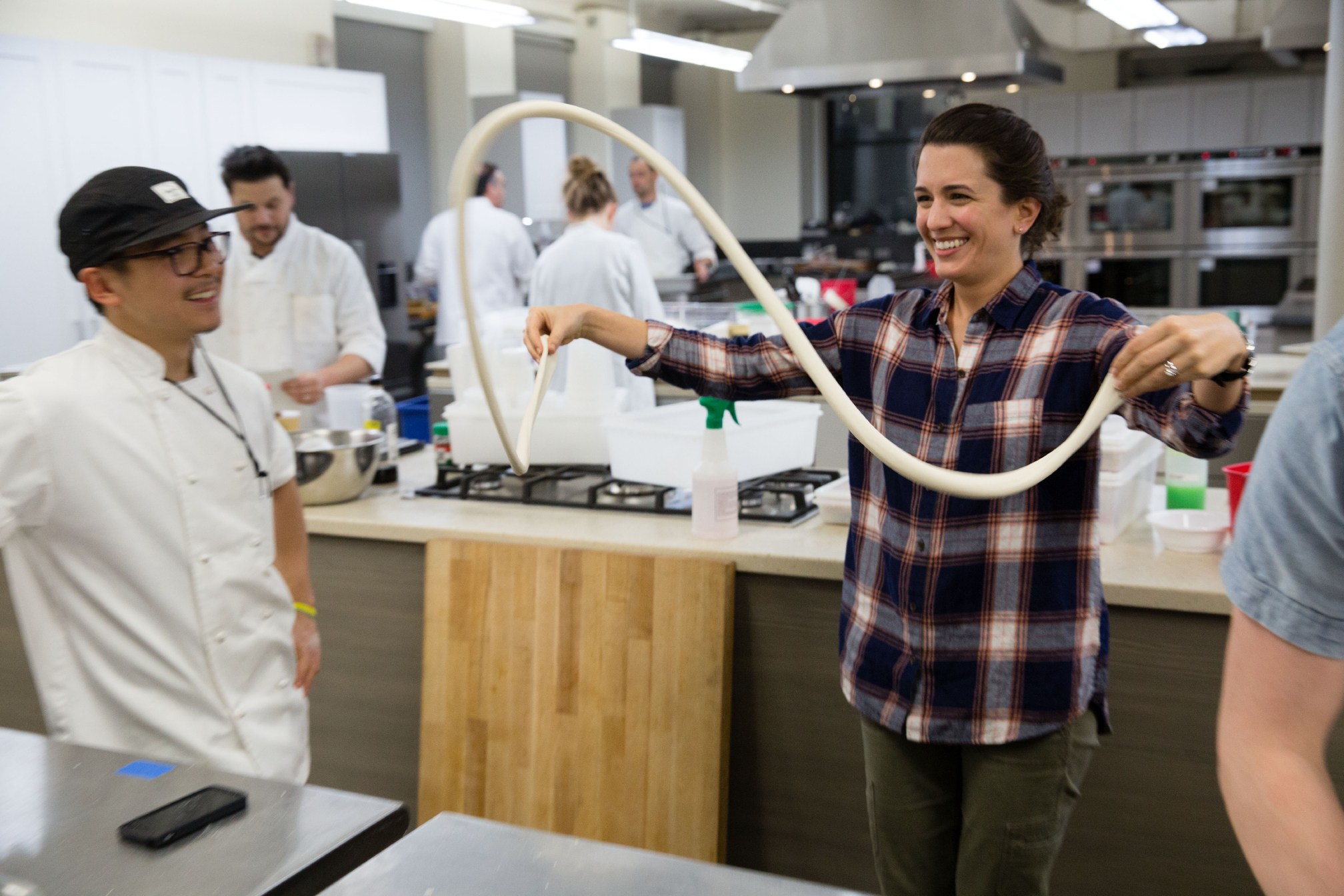
As for shaping, I arrived at a bit of a hybrid between the techniques I had seen at the local shops around Boston. I started with six small portions of dough. At first, I tried stretching and swinging each portion as they do at MDM—attempting to make gravity do the work. But my high-gluten formula needed a little more force to get the stretch I wanted. I then tried flattening each portion to a rectangle, then slapping the dough against the counter and pulling from both ends—just as I had seen at Gene’s. This technique proved much more successful, although I found I didn’t need to be nearly as violent (or angry). Instead, moderate slapping and gentle, even pulling from both ends was the key. Tearing the noodles in half lengthwise proved to be far simpler than expected—with even pressure in both directions it almost happened on its own. To make eating a little easier, I decided to cut the noodles in half crosswise as well, so that you weren’t dealing with such a long and awkward piece. (To all the traditionalists out there and grandmas rolling in their graves, I’m sorry in advance. I know it’s actually considered bad luck to have short noodles.)
With a little chile oil vinaigrette, these noodles were a breeze to make and delicious too. My team couldn’t get enough them. Kristin even said I could give Gene’s a run for its money. Click on over to the recipe to give it a shot yourself:
Flat Hand-Pulled Noodles (Biang Biang Mian) with Chili Oil Vinaigrette
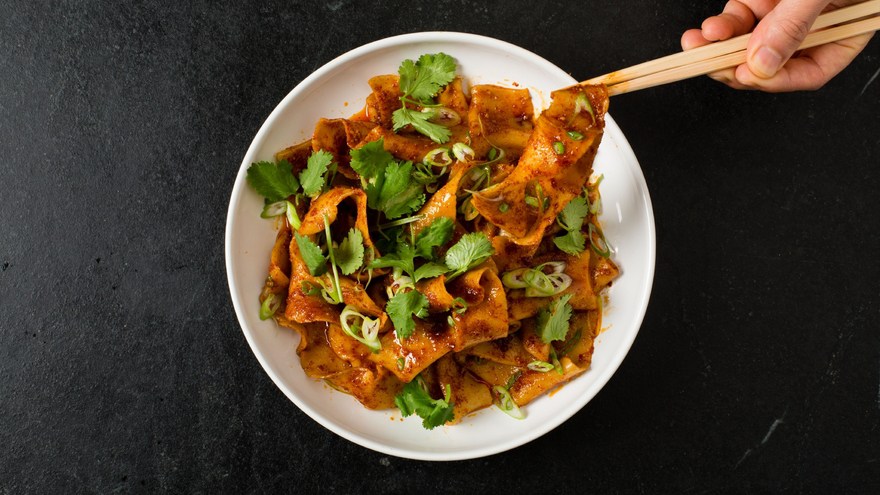
Field and test kitchen photography by Kevin White.
Styled food photography by Steve Klise.
